- Two types of automated lace – two carriage or one carriage systems ie Brother/Toyota versus Silver/Knitmaster
- Some machines can't do lace at all so do not have a lace carriage. This is due to inflexible needles (eg older machines, mid-gauge and bulky machines), or plastic bed machines (e.g. passap) – but there are other ways to achieve a lacy look e.g.
- Needles OOW (aka NOOW (new) lace, with thanks to Tony Bennett!)
- Hand manipulation on one or both beds
- Use of thick and thin yarns (punch/thread lace)
- Creating “sacrificial” stitches and then dropping them
- Holding position with NOOW
- Also, a combination of two techniques is possible on the two carriage systems, e.g. lace + knitweave etc.
- Think about using lifelines if you've done a lot of work (double this if you're using the ribber bed). Far less hassle to add in a lifeline than to try and fix a dropped stitch.
- Think about yarn choice - automatic lace is better with a slightly stretchy yarn so linen and cotton aren't an easy choice for the beginner
- Think about weights - lace sometimes needs lots of weight, and if you have "woolly weights" (magnetic) lace is perfect for that, no pesky claws pulling on your knitting.
- 90 deg rule - according to some manuals you're best to have the work hanging at 90 degrees from the main bed, so draped over the out of work ribber (cover it with a pillowcase or something similar). Some machines work just fine with the knitting hanging straight down, though - so don't forget to sample and check your machine's preference.
I came up with a chart (see below) about what's possible on what machines, I'm not quite sure it's 100% correct though, so feel free to comment.
I've added some pictures at the bottom of some samples I have. I don't have all of them sampled as yet. The shadow lace ones were actually done in college. I do have a sample of biasing lace but it's too small to show the actual effect. Ellen Turner made lots of zigzag strips of it and then sewed one of them into a circle, and then more around it, and made a lovely tablecloth with them. Alas, I don't seem to have a picture of it - must have been before I had a digital camera.
I've added some pictures at the bottom of some samples I have. I don't have all of them sampled as yet. The shadow lace ones were actually done in college. I do have a sample of biasing lace but it's too small to show the actual effect. Ellen Turner made lots of zigzag strips of it and then sewed one of them into a circle, and then more around it, and made a lovely tablecloth with them. Alas, I don't seem to have a picture of it - must have been before I had a digital camera.
Lace types
Hand-manipulated lace
- Needle out lace - decreases and needles taken out of work and put back in again - creates long floats, so do not use where floats will be an issue. Thanks to Bill King for this one!
- “Twisted bar” lace - adding an empty needle in twists the bars between out of work needles - this was something Iris Bishop figured out.
- Cables and lace - as above, with cabling added
- “Squiggle” lace - use holding position over groups of needles in work, and knit back and forth over two groups, gradually working across the bed and back again.
Lace without a lace carriage
- Tuck lace - needles out of work and tucking on the main bed - cancel end needle selection if your machine has it.
- Thread lace - this is a variation on fairisle, ie a thick and thin yarn are used. The thin yarn knits alone in some areas, and both yarns knit together in the other areas. Only certain machines have this capability.
Lace with a lace carriage
- Plain lace
- Lace motifs - using cams or programming to isolate parts of the pattern
- Fashion lace - moving stitches over in several passes so that the columns of stitches appear to bend
- “Fine” lace (Brother only) - transfers the selected stitch so as to share it between its original needle and its neighbour; produces a textured effect
- “Biasing” lace - continually transferring in the same direction over every other needle forces the material to bias
- Lace and knitweave - you can mix rows of knitweave and lace
- Lace and tuck
- Lace and fair-isle
- “Two needle out” lace - a variation on plain lace, you can actually have two needles out of work for a while to create a mesh effect - with thanks to Beryl Jarvis who discovered this.
- Thread lace aka punch lace - a variation on fairisle, this is achieved with thick and thin yarns instead. Some areas both yarns are knitted, and some areas only the thin yarn is used.
Double-bed “lace”
- Drive lace (all needles knit every row on RB, patterning Ns on MB released to form holes - hand-knit equivalent of double-wrapping certain stitches and dropping them on the next row
- Mesh knitting – as above, but this time the holes / bigger stitches dominate
- Shadow lace using jaws or transfer carriage - transferring stitches between beds to make holes
- Double-bed hand manipulated lace - using the ribber to create ribbed sections mixed with lace
- “Summer fair-isle” - stitches are created and dropped at the end of knitting the piece (a Passap technique).
- Double bed tuck lace - needles out of work, both beds tucking in opposite directions.
- Double bed tuck lace with racking - as above, with racking added.
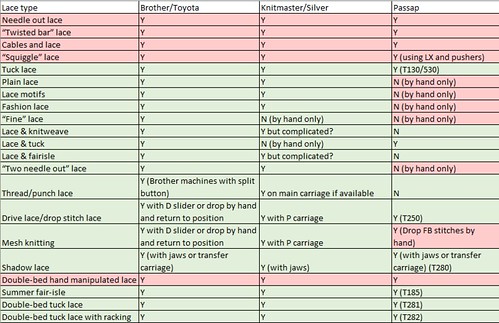
Click on this to embiggen - I gave up trying to make Blogger post a sensible table...
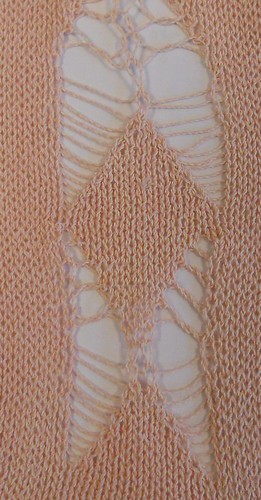
Needle-out lace

Twisted bar lace
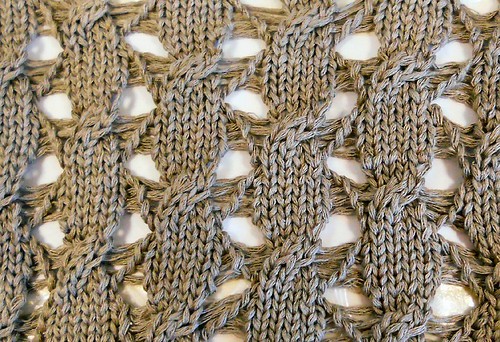
Cables and lace
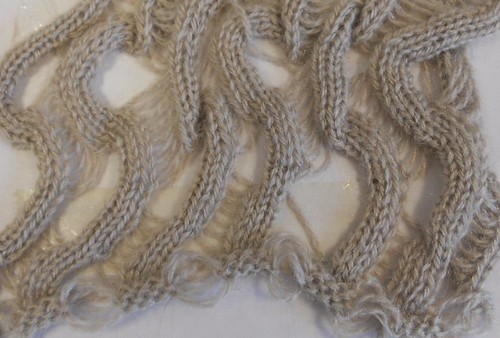
Squiggle lace
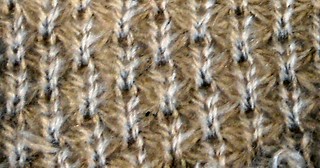

Tuck lace examples
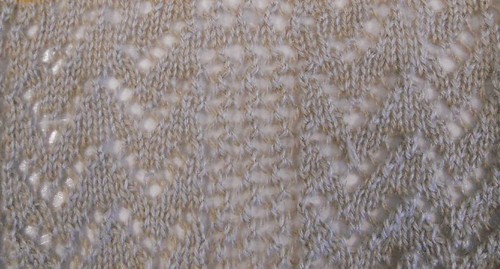
Plain lace
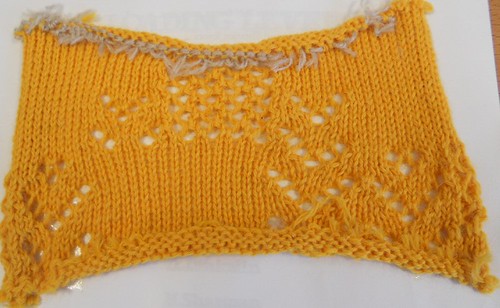
Lace motifs
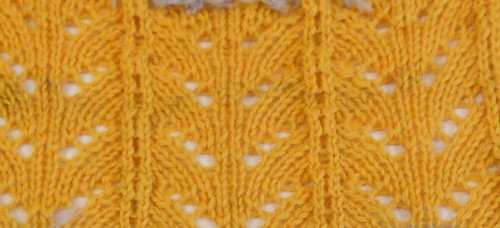
Fashion lace
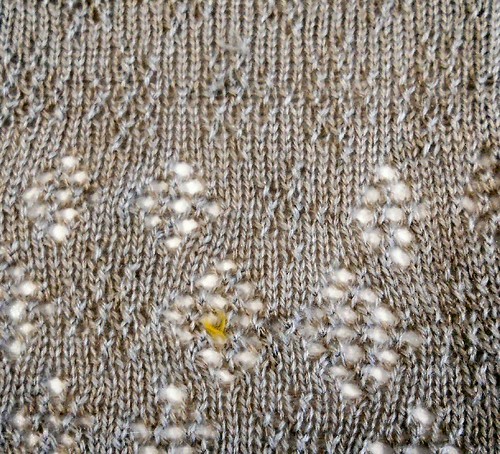
Fine lace

Lace and knitweave - the weaving yarn very kindly fills in the holes for an interesting two-colour effect. I need to knit a bigger sample of this I think!

"Two needle out" lace
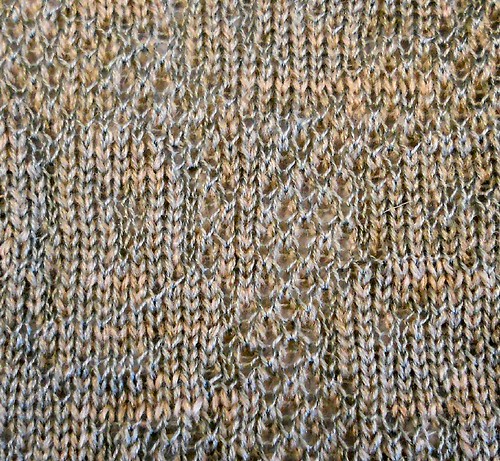
Thread lace
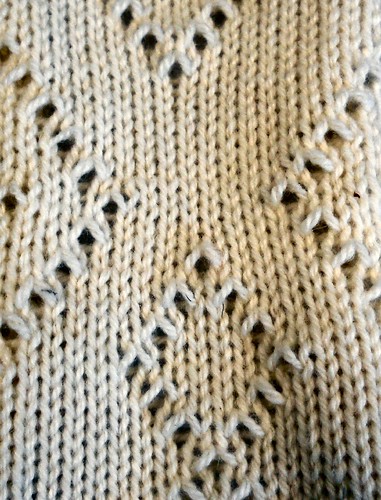
Drive lace

Mesh knitting


Shadow lace
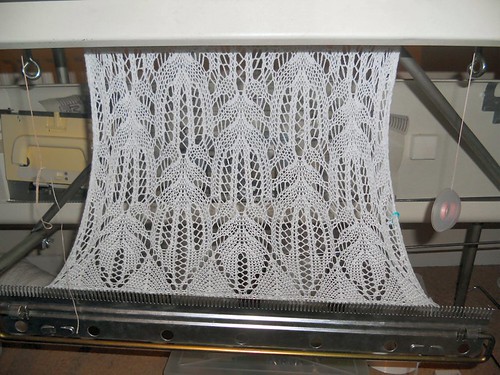
Double-bed hand-manipulated lace in progress

Double-bed tuck lace

3 comments:
These are beautiful - I hope there is somewhere I can learn how to do them!
NICE..
NICE.
Post a Comment